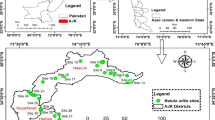Abstract
All Swedish forest land is at present being surveyed with the aim of mapping woodland key habitats which have an estimated number of ca. 70 000. An untested requirement of these habitats is that they should contain red-listed species. In order to investigate if they fulfill their aim, an inventory of nationally red-listed bryophytes and lichens was performed in ca. 120 randomly selected woodland key habitats distributed throughout the country. The species were recorded in line transects, covering the whole surface of the habitats. The mean number of red-listed species per habitat was 0.7 for bryophytes and 1.4 for lichens with 11 species at the richest site and 71% of the sites having at least one species. Nemoral forests and coniferous forests were the most species-rich habitat types. The habitats of northern Sweden were more species rich than the southern ones. There were weak correlations between presence of bryophytes and lichens. The study shows that a majority of the woodland key habitats contain red-listed bryophyte and lichen species. Further studies are needed in order to record more organism groups and to compare the woodland key habitats with the surrounding matrix forests.
Similar content being viewed by others
References
Aronsson M, Hallingbäck T and Mattson JE (eds) (1995) Rödlistade växter i Sverige 1995. Artdatabanken Uppsala [in Swedish with English summary]
Auzins R and Ek T Project plan for inventory of Woodland by Habitats. State Forest Service Latvia. Riga (in preparation)
Berg Å, Ehnström B, Gustafsson L, Hallingbäck T, Jonsell M and Weslien J (1994) Threatened plant, animal, and fungus species in Swedish forest: Distribution and habitat associations. Conservation Biology 8: 718–731
Bernes C (ed.) (1994) Biological diversity in Sweden. A country study. Monitor 14. Naturvårdsverkets förlag, Solna
Dobson AP, Rodriguez JP, Roberts WM and Wilcove DS (1997) Geographic distribution of endangered species in the United States. Science 275: 550–553
Esseen PA, Ehnström B, Ericson L and Sjöberg K (1997) Boreal forests. In: Hansson L ed. Boreal Ecosystems and Landscapes: Structures, Processes and Conservation of Biodiversity, Ecological Bulletins 46, pp 16–47. Munksgaard, Copenhagen
Hallingbäck T (1991) Mossor som indikerar skyddsvärd skog. Svensk Bot. Tidskr. 85: 321–384 [in Swedish with English abstract]
Hallingbäck T and Weibull H (1996) En värdepyramid för naturvårdsbedömning av ädellövskog. Svensk Bot. Tidskr. 90: 129–140 [in Swedish with English abstract]
Hatchwell BJ, Chamberlain DE and Perrins CM (1996) The demography of blackbirds Turdus merula in rural habitats; Is farmland a sub-optimal habitat? Journal of Applied Ecology 33: 1114–1124
Hultgren B (1995) Kontrolltaxering av nyckelbiotoper. Meddelande 1995-3. Skogsstyrelsen. Jönköping [in Swedish with English summary]
Jonsell M, Weslien J and Ehnström B (1998) Substrate requirements of red-listed saproxylic invertebrates in Sweden. Biodiversity and Conservation 7: 749–764
Mádail F and Quézel P (1997) Hot-spots analysis for conservation of plant biodiversity in the Mediterranean basin. Annals of the Missouri Botanical Gardens 84: 112–127
Meriluoto M (1995) Metsäluonnon arvokkaat elinympäristöt. Tunnistaminen ja hoitosuositukset. Metsäkeskus Tapion julkaisu 12/1995 [in Finnish]
National Board of Forestry (1997) Naturskydd och naturhänsyn i skogen. Meddelande 1-1997. Jönköping [in Swedish]
National Board of Forestry (1998a) Nyckelbiotoper. Jönköping [in Swedish]
National Board of Forestry (1998b) Skoglig statistikinformation 1998:15. Jönköping [in Swedish]
Nilsson NE (ed) (1990) The Forests. National Atlas of Sweden. SNA Publishing, Stockholm
Nilsson SG (1997) Biologisk mångfald under tusen år i det sydsvenska kulturlandskapet. Svensk Bot. Tidskr. 91: 85–101 [in Swedish with English summary]
Nitare J and Norén M (1992) Nyckelbiotoper kartläggs i nytt projekt vid Skogsstyrelsen. Svensk Bot. Tidskr. 86: 219–226 [in Swedish with English abstract]
Norén M, Hultgren B, Nitare J and Bergengren I (1995) Instruktion för Datainsamling vid inventering av nyckelbiotoper. National Board of Forestry. Jönköping [in Swedish]
Östlund L (1993) Exploitation and structural changes in the north Swedish boreal forest 1800–1992. PhD thesis, Department of Forest Vegetation Ecology. Swedish University of Agricultural Sciences, Umeå
SAS (1987) SAS/STAT guide for personal computers. Version 6. Cary, NC: SAS Institute Inc.
Tibell L (1992) Crustose lichens as indicators of forest continuity in boreal coniferous forests. Nordic Journal of Botany 12: 427–450
Author information
Authors and Affiliations
Rights and permissions
About this article
Cite this article
Gustafsson, L., De Jong, J. & Noréng, M. Evaluation of Swedish woodland key habitats using red-listed bryophytes and lichens. Biodiversity and Conservation 8, 1101–1114 (1999). https://doi.org/10.1023/A:1008934526658
Issue Date:
DOI: https://doi.org/10.1023/A:1008934526658




